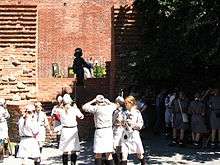Girl Guiding and Girl Scouting

A Guide, Girl Guide or Girl Scout is a member of a section of some Guiding organisations who is between the ages of 10 and 14. Age limits are different in each organisation. The term Girl Scout is used in the United States and several East Asian countries. The two terms are used synonymously within this article.
Girl Guides are organised into units/troops averaging 15-30 girls under guidance of a team of leaders. Units subdivide into patrols of about six Guides and engage in outdoor and special interest activities. Units may affiliate with national and international organisations. Some units, especially in Europe, have been co-educational since the 1970s, allowing boys and girls to work together as Scouts. There are other programme sections for older and younger girls.
Foundation
Following the origin of the Boy Scouts in 1907 many girls took up Scouting. A group of Girl Scouts were prominent at the Crystal Palace Rally in 1909. After Robert Baden-Powell formed The Boy Scouts Association in 1910 he formed the Girl Guides and asked his sister Agnes to look after the Girl Guides organisation. A few years later Baden-Powell's new wife Olave St Clair Baden-Powell (commonly referred to as "Lady Baden-Powell") became involved and, in 1918, was appointed Chief Guide.
Age groups and sections
Originally, the Guide program was aimed at 11- to 16-year-old girls. However, the younger sisters of Guides started to attend meetings, and so the Brownie section was started. A few years later the Ranger section was started for young women. Because of the large age and development span, many associations have split the 11- to 16-year age group into a junior and a senior section.
Activities
Most activities are similar to those of the (Boy) Scouts, but two central themes have been present from the earliest days of the movement: domestic skills and "a kind of practical feminism which embodies physical fitness, survival skills, camping, citizenship training, and career preparation".[1] These two themes have been emphasised differently at different times and by different groups, but have remained central to Girl Guiding and Girl Scouting.
Unit affiliation
Troop
Local groups, called variously units, companies or troops are the fundamental unit of the Girl Guides. These are run by an adult, normally a woman who is between 18 and 65 years of age. She has responsibility for the girls in her group and plans out activities for the girls as well as leading the meetings. These leaders are supported by assistants. Meetings are held anywhere from weekly to monthly depending on the commitments of the participants and the activities in progress.[2]
Solo
Girls who live too far away or have other reasons for not being able to belong to a troop can still be a Scout or Guide and participate remotely. In many countries they are called Lone Guides; however, in the United States they are called Juliettes after Juliette Gordon Low. Often they participate in the program by mail, radio, or internet.
References
- ↑ Aickin Rothschild, Mary (Autumn 1981). "To Scout or to Guide? The Girl Scout-Boy Scout Controversy, 1912-1941". Frontiers: A Journal of Women Studies. University of Nebraska Press. 6 (3): 115–121. doi:10.2307/3346224. ISSN 0160-9009. JSTOR 3346224.
- ↑ "Who We Are". Girlguiding UK. Archived from the original on 7 May 2007. Retrieved 2007-01-05.
